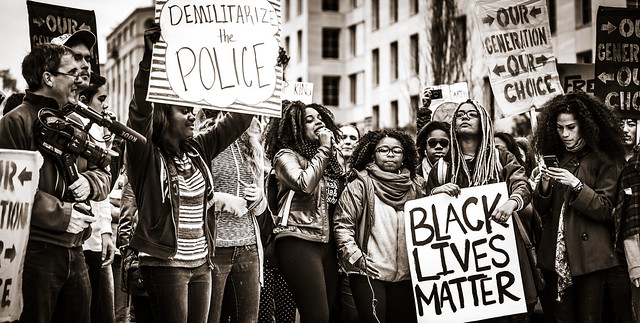Protests work when they escalate, refusing to be silenced. And right now, urgent cries for racial justice must not go unheard.
Published in the January 2016 issue of the New Internationalist.
‘This is not a good moment to make a scene. Let’s just cool down and give the system time to work.’
These sentiments perennially surface whenever disruptive protests command the public stage. And they have recently been voiced by critics of Black Lives Matter.
They are exactly wrong, both in spirit and logic.
Protests work when they escalate, refusing to be silenced. And right now, urgent cries for racial justice must not go unheard.
For more than a year, Black Lives Matter has been one of the United States’ most vibrant social-movement formations, rising up against police brutality and highlighting wider issues of state violence and structural racism.
Given the persistent stream of incidents in which black men have been murdered by law enforcement, occasions to rekindle indignation abound.
In November, the Midwestern city of Minneapolis, Minnesota, became a prominent flashpoint. There, protests erupted after the police shot and killed an unarmed 24-year-old black man named Jamar Clark. Black Lives Matter protesters promptly erected an occupation outside the city’s Fourth Precinct headquarters, demanding an independent federal investigation and the release of video footage of the shooting.
About a week after the occupation started, four men associated with white supremacist causes came to the site with an intention to provoke. All wore masks; at least one wore a bulletproof vest. As they were being escorted away, one turned and shot five people.
Thankfully, no-one was killed. But the official reaction to peaceful protests being met with racist violence was troubling. Activists reported that police on the scene told them, ‘This is what you all wanted, right.’
Politicians denounced the vigilantes, but they also turned against the protest occupation. The editorial board of the Minneapolis Star Tribune wrote that it was sensible for activists to ‘disband the tent camp for the safety of the demonstrators and the public’. Officials such as Mayor Betsy Hodges argued that the smoke from the campfires which demonstrators lit to endure Minnesota’s notoriously bitter winter nights were harming local air quality.
Given that the protests were taking place immediately outside a police station, the idea that activists had picked an unsafe location to rally seemed a bit dubious. And given the zeal with which legions of Minneapolis residents push smoke-spewing snowblowers, the concern about air pollution felt selective at best.
In truth, the criticisms were part of a long lineage of high-minded disapproval of those who demand discussion of topics that society would rather ignore. In the 1960s, civil rights activists staging demonstrations in cities such as Birmingham, Alabama, were constantly told that they were merely agitators looking for trouble. White leaders scolded them, insisting that negotiation, rather than sit-ins and marches, was the proper course of action.
Figures including Martin Luther King Jr did not deny that they were willing to court conflict. But they argued that only by dramatically highlighting injustices and altering public consciousness about the need for action would change become possible.
‘You are exactly right in your call for negotiation,’ King wrote. ‘Indeed… nonviolent direct action seeks to create such a crisis and establish such creative tension that a community that has constantly refused to negotiate is forced to confront an issue.’
This process of reckoning is sometimes uncomfortable, and it is invariably polarizing. Then as now, the response of hardcore racists to acts of nonviolent militancy has been hateful and even murderous. Yet by bringing this hatefulness into full view, members of the public are allowed to see the attitudes that linger beneath the surface of official ‘colour-blindness’. And they are forced to take sides.
The lesson of the civil-rights movement is that, in the face of attacks on peaceful protests, it is not time to return to a previous order of complacency.
It is a time for escalation.
__________
Photo Credit: Johnny Silvercloud, flickr.
